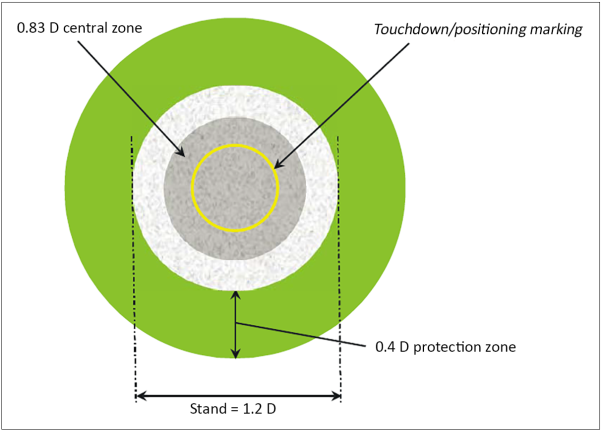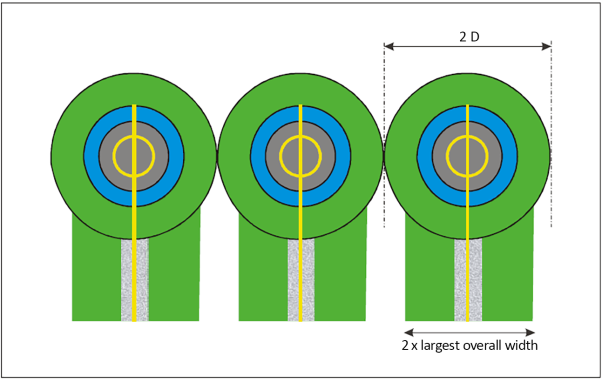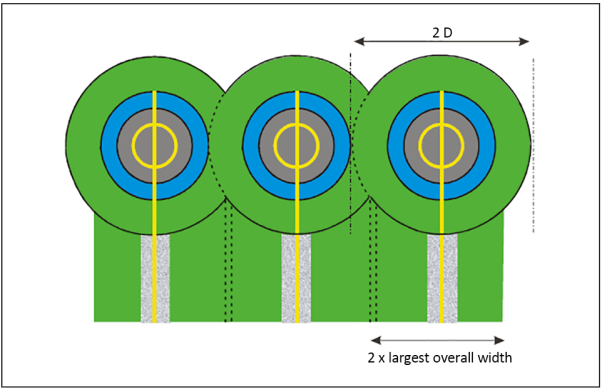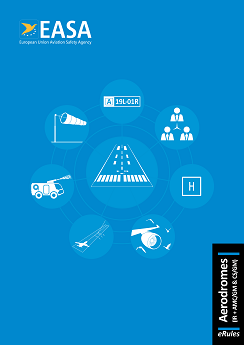CS HPT-DSN.D.300 Helicopter stands
ED Decision 2019/012/R
(a) Characteristics:
(1) When a TLOF is collocated with a helicopter stand, the protection area of the stand should not overlap the protection area of any other helicopter stand or associated taxi route.
(2) A helicopter stand should provide rapid drainage.
(3) The slope of a helicopter stand in any direction should not exceed 2 per cent.
(4) When used by helicopters turning in a hover, a helicopter stand should be of sufficient size to contain a circle of diameter of at least 1.2 D of the largest helicopter the stand is intended to serve (see Figure D-1).
(5) Where a helicopter stand is intended to be used for taxi-through and where the helicopter using the stand is not required to turn, the minimum width of the stand and associated protection area should be that of the taxi-route.
(6) Where a helicopter stand is intended to be used for turning, the minimum overall dimension of the stand and protection area should not be less than 2 D.
(7) Where a helicopter stand is intended to be used for turning, the helicopter stand should be surrounded by a protection area which extends for a distance of 0.4 D from the edge of the helicopter stand.

Figure D-1. Helicopter stand and associated protection area permitting the helicopter to turn in a hover when operating
(8) For simultaneous operations, the protection areas of helicopter stands and their associated taxi-routes should not overlap (see Figure D-2).
(9) A helicopter stand and the associated protection area intended to be used for air taxiing should provide ground effect.
(10) No fixed object should be permitted above the surface of the ground on a helicopter stand, except for tie-down points with a height of less than 5 cm, which can be accommodated if needed.
(11) No fixed object should be permitted above the surface of the ground in the protection area around a helicopter stand except for frangible objects which, because of their function, must be located there.
(12) No mobile object should be permitted on a helicopter stand and the associated protection area during helicopter movements.
(13) Objects whose function requires them to be located in the protection area at a distance of less than 0.75 D from the centre of the helicopter stand, should not exceed 5 cm in height.
(14) Objects whose function requires them to be located in the protection area should not:
(i) if located at a distance of less than 0.75 D from the centre of the helicopter stand, penetrate a plane at a height of 5 cm above the plane of the central zone; and
(ii) if located at a distance of 0.75 D or more from the centre of the helicopter stand, penetrate a plane at a height of 25 cm above the plane of the central zone and sloping upwards and outwards at a gradient of 5 per cent.
(15) The central zone of a helicopter stand should be capable of withstanding the traffic of helicopters it is intended to serve and have a static load-bearing area:
(i) of diameter not less than 0.83 D of the largest helicopter it is intended to serve; or
(ii) for a helicopter stand intended to be used for taxi-through, and where the helicopter using the stand is not required to turn, the same width as the helicopter ground taxiway.

Figure D-2. Helicopter stands designed for hover turns with air taxi-routes/taxiways — simultaneous operations
GM1 HPT-DSN.D.300 Helicopter stands
ED Decision 2019/012/R
(a) It is not considered good practice to locate helicopter stands under a flight path.
(b) Where non-simultaneous operations are envisaged, the protection areas of helicopter stands and their associated taxi-routes may overlap (see Figure GM1-D-1).
(c) Characteristics: For a helicopter stand intended to be used by wheeled helicopters for turning on the ground, the dimension of the helicopter stand and the protection area, including the dimension of the central zone, would need to be significantly increased.

Figure GM1-D-1. Helicopter stands designed for hover turns with air taxi-routes/taxiways − non-simultaneous operations
